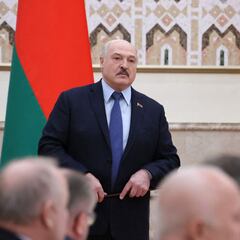Where are nuclear weapons on high alert and what does it mean to be on high alert?
Putin told his military commanders to put Russia’s nuclear deterrent on “special alert,” their highest level. What alert level are other nuclear powers at?

Russian president Vladimir Putin escalated the current tensions with NATO over his decision to send troops into neighboring Ukraine on Sunday when he told his military commanders to put his nation’s strategic nuclear forces on “special alert,” their highest level. This was in response to NATO powers’ making what he called “aggressive statements” and calling the sanctions imposed on Russia “illegal.”
The directive by the Russian leader is “unprecedented in the post-Cold War era," Daryl Kimball, of the Arms Control Association, told NBC News something no leader has done in the middle of a crisis from either country since. So far, senior US defense officials have said they “do not talk about our strategic posture as a matter of policy.”
Also see:
- What is a no-fly zone?
- Watch Zelensky documentary 'Servant of the People'
- American veterans fighting Russia in Ukraine
- Vladimir Putin lookalike: the innocent man scared for his life
- Republican senators criticised for potentially endangering President Zelesnkyy
US government officials have said that this is just another unnecessary escalation of the crisis. White House press secretary Jen Psaki told ABC's George Stephanopoulos on "This Week" that it’s part of a pattern by Putin of “manufacturing threats that don't exist in order to justify further aggression.”
In total there are nine countries that possess nuclear weapons. Only Russia has said that it has put its deterrent forces, including its nuclear arsenal on high alert at this time. However, both the US and Russia always keep a portion of their nuclear weapons at a heightened state of readiness.
The US and Russia have nuclear tipped ICBMs on high alert
Gone are the days during the Cold War when the US had bombers equipped with nuclear bombs flying around 24 hours a day. The program ended in 1968 after one of several accidents, but the bombers were kept on high alert until 1991 we President George HW Bush changed the policy. Now they can be ready to take off within 24 hours and not the 15 minutes as before.
The #StrategicDeterrence mission never stops and neither do we. Working around the clock in all conditions, #Maintainers from places like @TeamMinot Air Force Base ensure we are always #MissionReady.
— US Strategic Command (@US_Stratcom) January 10, 2022
#GlobalReadiness #AnytimeAnywhere #NuclearTriad pic.twitter.com/gZWyRhsCJX
However, the US and Russia have never taken their intercontinental ballistic missiles (ICBMs) off of high alert. Also referred to as prompt-launch status or launch-on-warning, missiles would only be launched if there were high confidence that an actual attack was on its way.
Basically, this means that both nations have their missiles that could reach virtually any part of the planet on a hair-trigger. As for Strategic Command, they would prefer to use the term “launch under attack.”
DEFCON levels, US state of readiness
The US uses a five-level defense readiness condition, called DEFCON, to indicate the alert state for the US military. It goes on a graduated scale from DEFCON 5, the lowest to DEFCON 1, which would signal the outbreak of nuclear war. Although the US doesn’t make public the current readiness level, during the Cuban Missile Crisis in October 1962 NORAD declared an alert level of DEFCON 3. It remained in place until 27 November the same year.
How long does the US or Russia have to respond to an attack?
Both nations have sophisticated early-warning systems to detect the launch of a potentially nuclear tipped ballistic missile. If it were to happen, once a launch has been detected, political and military leaders would have very little time to evaluate the credibility of any warning.
From launch to destination at most would take an ICBM about 30 minutes, much less for ballistic missiles launched from a submarine (SLBMs). This means either president would have at best 15 minutes to make the call to order a retaliatory strike in order to get their nation's ICBMs in the air before they could be destroyed.
The latest casualty of Putin’s “peacekeeping” in Ukraine: Biden Ends Russian Arms Control Talks Amid Ukraine Invasion. https://t.co/zf155bG9iy
— Hans Kristensen (@nukestrat) February 25, 2022
The New START treaty is still in place, although therehave been no on-site inspections for 2 years. The treaty expires in only 4 years. pic.twitter.com/JaYSJxDD1W
The chances for human or technical error, especially in cases of heightened tensions, have led former military leaders from both countries to call for taking ICBMs off a hair-trigger alert. Unlike bombers, an ICBM can not be called back to base, nor do they have self-destruct mechanisms.
US and Russia sign a New START to limit nuclear warheads
In 2021, the US and Russia renewed the New Strategic Arms Reduction Treaty, or New START, which limits the number of nuclear warheads either nation can have deployed and the total number in their arsenals for five more years.
Related stories
The treaty allows them to maintain a total of 1,550 nuclear warheads on deployed ICBMs, SLBMs, and heavy bombers equipped for nuclear armaments. Each bomber deployed counts as one warhead, thus limiting the number of nuclear-equipped aircraft at each nation’s disposal.
Those warheads can be deployed on a maximum of 700 ICBMs, SLBMs and heavy bombers equipped to carry nuclear weapons combined. Furthermore, it limits each nation to 800 deployed launchers for ICBMs, SLBMs and heavy bombers. Each ballistic missile can carry more than one warhead.


